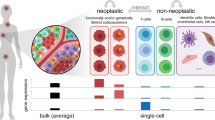Abstract
Gene expression microarrays hold great promise for studies of human disease states. There are significant technical issues specific to utilizing clinical tissue samples which have yet to be rigorously addressed and completely overcome. Precise, quantitative measurement of gene expression profiles from specific cell populations is at hand, offering the scientific community the first comprehensive view of the in vivo molecular anatomy of normal cells and their diseased counterparts. Here, we propose a model for integrating—in three dimensions—expression data obtained using the microarray.
This is a preview of subscription content, access via your institution
Access options
Subscribe to this journal
Receive 12 print issues and online access
$209.00 per year
only $17.42 per issue
Buy this article
- Purchase on Springer Link
- Instant access to full article PDF
Prices may be subject to local taxes which are calculated during checkout


Similar content being viewed by others
References
Nowak, R. Entering the postgenome era. Science 270, 368–371 (1995).
Abbott, A. DNA chips intensify the sequence search. Nature 379 , 392 (1996).
Schena, M. et al. Quantitative monitoring of gene expression patterns with a complementary DNA microarray. Science 270, 467– 469 (1995).
Velculescu, V. et al. Serial analysis of gene expression. Science 270, 484–487 (1995).
DeRisi, J. et al. Use of a cDNA microarray to analyse gene expression patterns in human cancer. Nature Genet. 14, 457– 460 (1996).
Schena, M. et al. Microarrays: biotechnology's discovery platform for functional genomics. Trends Biotechnol. 16, 301– 306 (1998).
Ramsay, G. DNA chips: state of the art. Nature Biotechnol. 16, 40–44 (1998).
Bowtell, D.L. Options available—from start to finish—for obtaining expression data by microarray. Nature Genet. 21, 25 –32 (1999).
Strausberg, R.L., Dahl C.A. & Klausner R.D. New opportunities for uncovering the molecular basis of cancer. Nature Genet. 16, 415– 416 (1997).
Murphy, G.P. et al. Histopathology of localized prostate cancer. Consensus conference on diagnosis and prognostic parameters in localized prostate cancer. Scand. J. Urol. Nephrol. Suppl. 162, 7– 42 (1994).
Epstein, J.I. Pathologic evaluation of prostatic carcinoma: critical information for the oncologist. Oncology 10, 527– 534 (1996).
Bostwick, D.G. & Montironi R. Evaluating radical prostatectomy specimens: therapeutic and prognostic importance. Virchows Arch. 430, 1–16 (1997).
Small, E.J. Update on the diagnosis and treatment of prostate cancer. Curr. Opin. Oncol. 10, 244–252 (1998).
Pettaway, C.A. Prognostic markers in clinically localized prostate cancer. Tech. Urol. 4, 35–42 ( 1998).
Klimecki, W.T., Futscher, B.W. & Dalton, W.S. Effects of ethanol and paraformaldehyde on RNA yield and quality. Biotechniques 16, 1021– 1023 (1994).
Deng, G., Lu, Y., Zlotnikov, G., Thor, A.D. & Smith, H.S. Loss of heterozygosity in normal tissue adjacent to breast carcinomas. Science 20, 2057– 2059 (1996).
Chuaqui, R.F. et al. PB39: identification of a novel gene up–regulated in clinically aggressive human prostate cancer. Urology 50, 302–307 (1997).
Zhuang, Z. et al. Barrett's esophagus: metaplastic cells with loss of heterozygosity at the APC gene locus are clonal precursors to invasive adenocarcinoma. Cancer Res. 56, 1961–1964 (1996).
Hung, J. et al. Allele–specific chromosome 3p deletions occur at an early stage in the pathogenesis of lung carcinoma. J. Amer. Med. A 273, 1908–1910 (1995).
Bostwick, D. & Brawer, M.K. Prostatic intra–epithelial neoplasia and early invasion in prostate cancer. Cancer 59, 788–794 (1987).
Bostwick, D.G. Progression of prostatic intraepithelial neoplasia to early invasive adenocarcinoma. Eur. Urol. 30, 145–152 (1996).
Isaacs, W. et al. genetic alterations in prostate cancer. Cold Spring Harb. Symp. Quant. Biol. 59, 653–659 (1994).
Latil, A. & Lidereau, R. Genetic aspects of prostate cancer. Virchows Arch. 432, 389– 406 (1998).
Dong J.T., Isaacs, W.B . & Isaacs, J.T. Molecular advances in prostate cancer. Curr. Opin. Oncol. 9, 101–107 (1997).
Lalani, E.N., Stubbs, A. & Stamp, G.W. Prostate cancer; the interface between pathology and basic scientific research. Semin. Cancer Biol. 8, 53–59 (1997).
Hayward, S.W., Grossfeld, G.D., Tlsty, T.D. & Cunha G.R. Genetic and epigenetic influences in prostatic carcinogenesis. Int. J. Oncol. 13, 35–47 (1998).
MacDougall, J. & Matrisian, L.M. Contribution of tumor and stromal matrix metalloproteinases to tumor progression, invasion and metastasis. Cancer Metastasis Rev. 14, 351–362 (1995).
McCoy, K. et al. An acid protease secreted by transformed cells interferes with antigen processing. J. Cell Biol. 106, 1879 –1884 (1988).
Emmert–Buck, M.R. et al. Allelic loss on chromosome 8p12–21 in microdissected prostatic intraepithelial neoplasia (PIN). Cancer Res. 55, 2959–2962 (1995).
Bostwick D.G. Prospective origins of prostate carcinoma. Prostatic intraepithelial neoplasia and atypical adenomatous hyperplasia. Cancer 78, 330–336 (1996).
Eberwine, J. Amplification of mRNA populations using aRNA generated from immobilized oligo(dT)–T7 primed cDNA. Biotechniques 20, 584– 591 (1996).
Bassett, D.E. Jr, Eisen, M.B. & Boguski, M.S. Gene expression informatics—it's all in your mine. Nature Genet. 21, 51– 55 (1999).
Emmert–Buck, M. et al. Increased gelatinase A and cathepsin B activity in invasive tumor regions of human colon cancer samples. Am. J. Pathol. 145, 1285–1290 (1994).
Giometti, C.S., Williams, K. & Tollaksen, S.L. A two–dimensional electrophoresis database of human breast epithelial cell proteins. Electrophoresis 16, 1187–1189 (1997).
Ching J., Voivodov, K.I. & Hutchens, T.W. Polymers as surface–based tethers with photolytic triggers enabling laser–induced release/desorption of covalently bound molecules. Bioconjug. Chem. 7, 525– 528 (1996).
Kuwata, H. et al. Bactericidal domain of lactoferrin: detection, quantitation, and characterization of lactoferricin in serum by SELDI affinity mass spectrometry. Biochem. Biophys. Res. Commun. 245, 764 –773 (1998).
Suzuki, H. et al. Interfocal heterogeneity of PTEN/MMAC1 gene alterations in multiple metastatic prostate cancer tissues. Cancer Res. 58, 204–209 (1998).
Wiltshire, R. et al. Direct visualization of the clonal progression of primary cutaneous melanoma: application of tissue microdissection and comparative genomic hybridization. Cancer Res. 55, 3954 –3957 (1995).
Vocke, C. et al. Analysis of 99 microdissected prostate carcinomas reveals high frequency of allelic loss on chromosome 8p12–21. Cancer Res. 56, 2411–2416 ( 1996).
Bova, G.S. & Isaacs, W.B. Review of allelic loss and gain in prostate cancer. World J. Urol. 14, 338 –346 (1996).
Emmert–Buck, M.R. et al. Laser capture microdissection. Science 274, 998–1001 (1996).
Bonner, R.F. et al. Laser capture microdissection: molecular analysis of tissue. Science 278, 1481–1483 (1997).
Krizman, D.B. et al. Construction of a representative cDNA library from prostatic intraepithelial neoplasia (PIN). Cancer Res. 56, 5380–5383 (1996).
Levedakou, E.N. et al. Two novel human serine/threonine kinases with homologies to the cell cycle regulating Xenopus MO15, and NIMA kinases: cloning and characterization of their expression pattern. Oncogene 9, 1977–1988 (1994).
Kallajokl, M., Alanen, K.A., Nevalainen, M. & Nevalainen, T.J. Group II phsopholipase A2 in human male reproductive organs and genital tumors. Prostate 35, 263–272 (1998).
Imajoh–Ohmi, S. et al. Lactacystin, a specific inhibitor of the proteasome, induces apoptosis in human monoblast U937 cell. Biochem. Biophys. Res. Commun. 217, 1070–1077 ( 1995).
Taylor, I.C. et al. Mouse mammary tumors express elevated levels of RNA encoding the murine homology of SKY, a putative tyrosine kinase. J. Biol. Chem. 270, 6872–6880 ( 1995).
Acknowledgements
We gratefully acknowledge the contributions of the following team members and collaborators of the CGAP Molecular Fingerprinting effort. J.W. Gillespie, V.V. Prabhu, P.J. Munson, R.F. Bonner, A. Lash, D.K. Ornstein, J. Herring, L. Grouse, P.H. Duray, C.D. Vocke, J. Swalwell, M.R. Brown, C. Englert, E.F. Petricoin, S. Pan, J. Pfeifer, C. Johnson, R.D. Klausner, W. M. Linehan, L.A. Liotta and R. Strausberg.
Author information
Authors and Affiliations
Rights and permissions
About this article
Cite this article
Cole, K., Krizman, D. & Emmert–Buck, M. The genetics of cancer—a 3D model. Nat Genet 21 (Suppl 1), 38–41 (1999). https://doi.org/10.1038/4466
Issue Date:
DOI: https://doi.org/10.1038/4466
This article is cited by
-
Protein Tyrosine Phosphatase 4A2 Expression Predicts Overall and Disease-Free Survival of Human Breast Cancer and Is Associated with Estrogen and Progestin Receptor Status
Hormones and Cancer (2013)
-
Identification of unique expression signatures and therapeutic targets in esophageal squamous cell carcinoma
BMC Research Notes (2012)
-
Relationships of ESR1 and XBP1 expression in human breast carcinoma and stromal cells isolated by laser capture microdissection compared to intact breast cancer tissue
Endocrine (2011)
-
Integrating complex genomic datasets and tumour cell sensitivity profiles to address a 'simple' question: which patients should get this drug?
BMC Medicine (2009)



